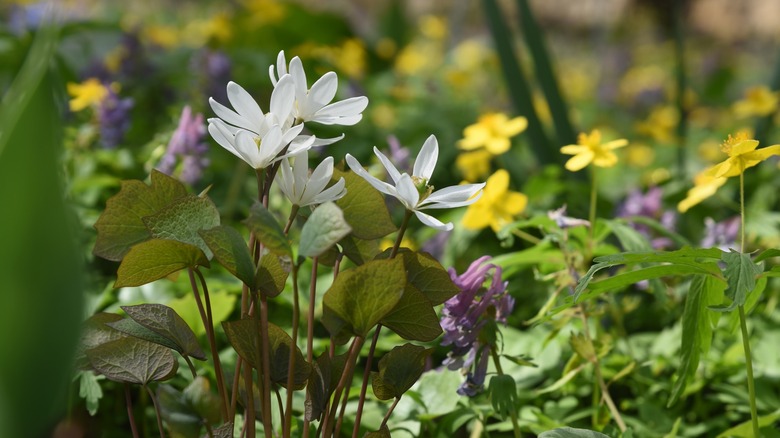Shady Conditions Aren't A Problem For This Unique White Wildflower
We all know the frustrations of trying to find the perfect plant for the shade, where it's easy to grow weeds, but hard to grow flowers. Some blooms, like the twinleaf (Jeffersonia diphylla), thrive in shade. This wild perennial is one of several plants that need shade, or less than three hours of sunlight a day.
The twinleaf, part of the Barberry family, grows a pretty white flower, and you can find it in many forests in North America. It's best suited for USDA Hardiness Zones 4 through 9 and should be planted ideally in late summer or early fall. Twinleaf, so named for its split leaf pattern that mimics a pair of butterfly wings, can reach heights of up to a foot and a half. Their inch or so wide white flowers bloom in April or May.
The twinleaf doesn't require a lot of fuss, but they do prefer limestone soil and damp conditions, as long as there's decent drainage. They crave shade, and in the wild, are usually found at the base of trees, hiding from full sun. Twinleaf does best when it gets partial sunlight during the spring — for example, before trees grow their full foliage. Be patient when growing twinleaf, as it might take a couple of years before the flowers begin to bloom in earnest, but once they do, they'll be a beautiful addition to your garden.
Add these other shade-loving flowers to your garden
Twinleaf isn't the only flower that loves shade. You can add some additional fragrant shade-loving plants, such as the partridge berry (Mitchella repens) – a kind of non-invasive ground cover that thrives in shade and offers fragrant, small white blooms. Or you could plant ruby spice (Clethra alnifolia), with its white flowers that smell amazing and arrive by late summer.
Other plants that do well in shade typically have thin, but broad leaves, like the ground covers wild ginger (Asarum canadense) and plumbago (Ceratostigma plumbaginoides). Twinleaf, however, might not thrive if there's too much competition, especially by more invasive weeds, so be sure to give it enough space to grow.
Keep in mind when gardening in the shady spots of your yard that shady soil doesn't need to be watered as much because it tends to retain moisture longer. Sometimes this presents a challenge, as soil can become waterlogged and nutrients can become diluted. Learn how to drain wet flower beds by installing a French drain or dry well if the ground is too soggy. One way to ensure shady spots have nutrient-rich soil and don't get waterlogged is to add a mixture of compost and dry mulch to your soil. This will help create better conditions for your twinleaf and other shade-loving flowers to grow.

